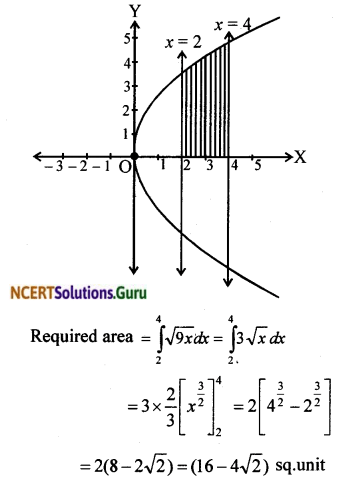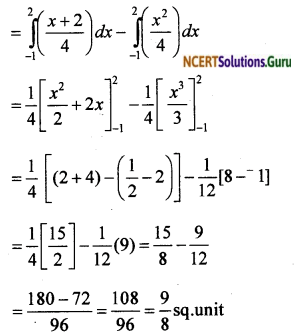NCERT Solutions for Class 12 Maths Chapter 9 Differential Equations Ex 9.5
These NCERT Solutions for Class 12 Maths Chapter 9 Differential Equations Ex 9.5 Questions and Answers are prepared by our highly skilled subject experts. https://mcq-questions.com/ncert-solutions-for-class-12-maths-chapter-9-ex-9-5/
NCERT Solutions for Class 12 Maths Chapter 9 Differential Equations Exercise 9.5
![]()
Question 1.
(x²+xy)dy = (x²+y²)dx
Solution:

Question 2.
y’ = \(\frac { x+y }{ x }\)
Solution:
We have x.\(\frac { dy }{ dx }\) = x + y
LHS as \(\frac { dy }{ dx }\) and convert RHS as a function of \(\frac { y }{ x }\) a homogeneous differential equation substitute v for \(\frac { y }{ x }\) differential y w.r.t. x put the values of \(\frac { dy }{ dx }\) and \(\frac { y }{ x }\) in (1) variable separble equation of v and x Replace the value of v by \(\frac { y }{ x }\)

which the required general solution.
![]()
Question 3.
(x – y)dy – (x + y)dx = 0
Solution:
(x – y)dy – (x + y)dx = 0
i.e., (x – y)dy = (x + y)dx

is a homogeneous differential equation

Question 4.
(x² – y²)dx + 2xy dy = 0
Solution:
(x² – y²)dx + 2xy dy = 0
2xy dy = (x² – y²)dx

is a homogeneous differential equation

which the required general solution.
![]()
Question 5.
x²\(\frac { dy }{ dx }\) = x² – 2y² + xy
Solution:
\(\frac { dy }{ dx }\) = \(\frac{x^{2}-2 y^{2}+x y}{x^{2}}\)
\(\frac { dy }{ dx }\) = \(1-2\left(\frac{y}{x}\right)^{2}+\left(\frac{y}{x}\right)\) … (1)
is a homogeneous differential equation

Question 6.
\(xdy-ydx=\sqrt { { x }^{ 2 }+{ y }^{ 2 } } dx\)
Solution:

Question 7.
\(\left\{ xcos\left( \frac { y }{ x } \right) +ysin\left( \frac { y }{ x } \right) \right\} ydx=\left\{ ysin\left( \frac { y }{ x } \right) -xcos\left( \frac { y }{ x } \right) \right\} xdy\)
Solution:

is a function of \(\frac { y }{ x }\)
∴ The given differential equation is homogeneous.

is the general solution of the differential equation.
![]()
Question 8.
\(x\frac { dy }{ dx } -y+xsin\left( \frac { y }{ x } \right) =0\)
Solution:
\(x\frac { dy }{ dx } -y+xsin\left( \frac { y }{ x } \right) =0\)
i.e., x\(\frac { dy }{ dx }\) = y – xsin\(\frac { y }{ x }\)
\(\frac { dy }{ dx }\) = \(\frac { y }{ x }\) – sin(\(\frac { y }{ x }\)) is a homogeneous differential equation.
Put \(\frac { y }{ x }\) = v ⇒ y = vx and \(\frac { dy }{ dx }\) = v + x\(\frac { dv }{ dx }\)

is the general solution.
Question 9.
\(ydx+xlog\left( \frac { y }{ x } \right) dy-2xdy=0\)
Solution:

Question 10.
\(\left( { 1+e }^{ \frac { x }{ y } } \right) dx+{ e }^{ \frac { x }{ y } }\left( 1-\frac { x }{ y } \right) dy=0\)
Solution:

is a homogeneous differential equation.
Put v = \(\frac { x }{ y }\), ∴ x = vy
Differentiating w.r.t. y we get

\(x+y e^{\frac{x}{y}}=C\), is the general solution of the differential equation.
![]()
Question 11.
(x + y) dy+(x – y)dx = 0,y = 1 when x = 1
Solution:

Question 12.
x²dy + (xy + y²)dx = 0, y = 1 when x = 1
Solution:
x²dy + (xy + y²)dx = 0
x²dy = – (xy + y²) dx

Question 13.
\(\left[x \sin ^{2}\left(\frac{y}{x}\right)-y\right] d x+x d y=0 ; y=\frac{\pi}{2}\)
Solution:

Question 14.
\(\frac { dy }{ dx }\) – \(\frac { y }{ x }\) + cosec\(\frac { y }{ x }\) = 0; y = 0 when x = 1
Solution:
\(\frac { dy }{ dx }\) – \(\frac { y }{ x }\) + cosec\(\frac { y }{ x }\) = 0 is a homogeneous differential equation.

Question 15.
\(2xy+{ y }^{ 2 }-{ 2x }^{ 2 }\frac { dy }{ dx } =0,y=2,when\quad x=1\)
Solution:

![]()
Question 16.
A homogeneous equation of the form \(\frac{d x}{d y}=h\left(\frac{x}{y}\right)\) can be solved by making the substitution,
(a) y = vx
(b) v = yx
(c) x = vy
(d) x = v
Solution:
\(\frac{d x}{d y}=h\left(\frac{x}{y}\right)\) is a homogeneous equation.
Hence the substitution is \(\frac { x }{ y }\) = v or x = vy
Question 17.
Which of the following is a homogeneous differential equation?
(a) (4x + 6y + 5)dy – (3y + 2x + 4)dx = 0
(b) \((x y) d x-\left(x^{3}+y^{3}\right) d y=0\)
(c) \(\left(x^{3}+2 y^{2}\right) d x+2 x y d y=0\)
(d) \(y^{2} d x+\left(x^{2}-x y-y^{2}\right) d y\)
Solution:
(d) \(y^{2} d x+\left(x^{2}-x y-y^{2}\right) d y\)

Hence it is a homogeneous differential equation.
NCERT Solutions for Class 12 Maths Chapter 9 Differential Equations Ex 9.5 Read More »



































































































